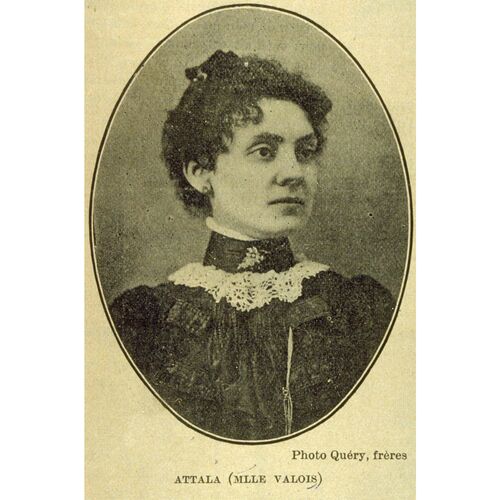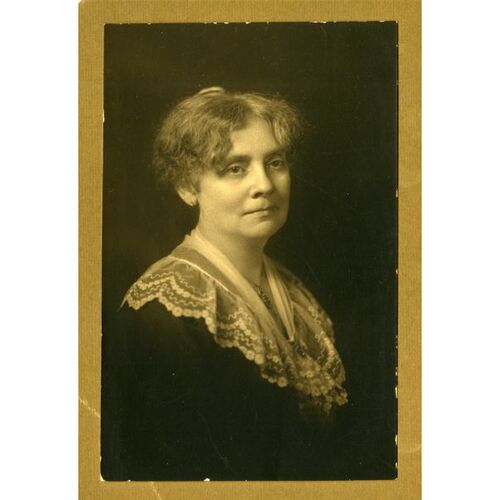VALOIS, LÉONISE (baptized Marie-Attala-Amanda-Léonise), known as Atala (she signed Attala until 1910), poet, journalist, and office holder; b. 11 Oct. 1868 in Vaudreuil (Vaudreuil-Dorion), Que., fifth of the 15 children of Louis-Joseph-Avila Valois, a physician, and Marie-Louise Bourque; d. unmarried 20 May 1936 in Montreal and was buried in the cemetery in her hometown.
Léonise Valois was born into a relatively privileged milieu that was highly politicized. Her grandfather Joseph-Eustache Valois supported the Patriotes during the 1830s. Because her father was an ardent Liberal activist, the family was able to establish ties with prominent figures in political circles, such as Rodolphe Lemieux, the love of Léonise’s youth. The Valois were also closely connected with the Roman Catholic elite. The future archbishop of Montreal Paul Bruchési, for example, would become a family friend. Louis-Joseph-Avila Valois was not particularly rich, but some of his relatives had sizeable fortunes.
It was through the financial backing of one of their female cousins that the Valois daughters were able to pursue fairly advanced education. After elementary schooling with the Sisters of St Anne in Vaudreuil from 1872 to 1879, Léonise was a boarder at the convent of the Sisters of the Holy Names of Jesus and Mary in Beauharnois from 1880 to 1883. On completing her studies, she helped her father to keep the books and assisted him with his patients, while her elder sisters shared with their mother the household tasks of a large family. Wishing to rebuild a dwindling clientele and to find good husbands for his older daughters, Dr Valois considered moving, and in 1886 the family settled in Sainte-Cunégonde (Montreal). Around 1888 Léonise spent a short period with the Religieuses du Sacré-Cœur at the convent in Sault-au-Récollet (Montreal), but she could not tolerate the discipline they imposed and left the community.
Léonise’s family was no stranger to the world of letters; her father occasionally wrote verse. It would seem that she became drawn to poetry and writing while she was at school, since her earliest known poem dates from 1882. She made her literary debut in 1889 when, under the pseudonym of Attala, she got some poems published in three issues of Le Recueil littéraire (Sainte-Cunégonde), of which Édouard-Zotique Massicotte* was the subeditor. This periodical was noted for its avant-garde literary approach, as well as for its openness to young people and women as authors and readers. Although nothing immediately ensued from this first publication, she was beginning to realize a literary dream that was neither common nor acknowledged in that era.
In the course of the 1890s the Valois family experienced financial difficulties. Since the people of Sainte-Cunégonde were quite poor, Dr Valois struggled to earn an income that would enable him to meet his heavy responsibilities to his dependants. Overwhelmed, he took sick and died in 1898. Léonise, and her sister Philomène, now had to support the family and find employment; thus she would work for a few years in the registry office of the City of Montreal. Because of this personal responsibility, she could devote herself to writing only intermittently.
In the same period, Léonise Valois embarked on a poorly paid career as a journalist. Like several other female writers in the province, she was in charge of the women’s pages for a Montreal periodical, or contributed to them. She had her byline on “Au coin du feu” in Le Monde illustré from October 1900 until the column was dropped in December 1901; Massicotte was the paper’s editor. Attala wrote next for the daily La Presse in 1902, for Robertine Barry*’s Le Journal de Françoise in 1903–4, and for Le Canada in 1904. From 1903 to 1905 she also contributed to Anne-Marie Gleason*’s column “Le royaume des femmes” in the daily La Patrie. In addition, she had a few articles appear in 1907 in L’Écho de Vaudreuil: purement local, which was published in Rigaud. Seeking a more stable income, she found a job in a Montreal post office that year, and she would continue working for the Post Office Department until she retired in 1929.
Despite heavy demands on her time, Léonise remained faithful to the world of literature. In 1910, in Montreal, she brought out Fleurs sauvages: poésies, the first collection devoted exclusively to poetry by a French Canadian woman. The cover was designed and drawn by Albert Ferland*, a poet and friend who worked with her at the Post Office. Her romantic poetry, which was both lyrical and patriotic, was well received on the whole. Even before the publication of Fleurs sauvages, Léonise was recognized as a poet by her fellow writers and journalists. She published little during the following years except for a few articles in the Montreal periodicals L’Autorité nouvelle and La Revue moderne. She returned to journalism, however, in 1929, shortly after retiring from the Post Office, when her cousin Aldéric Lalonde, president of the Union Catholique des Cultivateurs, offered her a position as editor of the women’s pages of the association’s official newsletter, La Terre de chez nous (Montréal). She seized the opportunity. In 1931 a serious accident, from which she would never fully recover, put a sudden end to this collaboration.
Although very weak, Léonise published a second volume of poems, Feuilles tombées (with a preface by Lionel Groulx*) in Montreal in 1934, as well as a re-edition of Fleurs sauvages. The new collection was a sequel to the first, but with darker accents marked by themes of mourning, death, and absence. Many critics hailed its publication. Housebound by illness in 1935, she died on 20 May 1936, a few days after winning the annual poetry competition of the Société des Poètes Canadiens-Français. This would be her sole literary award.
Léonise Valois was one of the pioneers of women’s journalism in the late 19th and early 20th centuries, following in the footsteps of Joséphine Marchand*, Robertine Barry, and Anne-Marie Gleason. In some 200 columns on subjects such as celibacy, feminism, the necessity of education for women, their financial independence, equality within marriage, and the condition of female teachers, Valois, writing as Atala, helped to advance women’s thinking and to support their finding of their voice. To have been the first woman in French Canada who brought together a collection of her own poems remains, however, her most important contribution to literary history and women’s history. In so doing, despite domestic and social obstacles, and against the traditional model that sought to restrict women to enjoying literature as a pastime, she pursued her dream and earned, as a poet, the title of “woman of letters” that she coveted.
In her private archives (Saint-Alphonse-Rodriguez, Québec), the author has numerous documents produced by Léonise Valois over the course of her life. A research file pertaining to Valois is available at the Centre d’Histoire la Presqu’île (Vaudreuil-Dorion, Québec). In addition to her columns, Valois left behind around 60 published poems as well as texts that were never published; several pages of these can be found in the author’s Léonise Valois, femme de lettres (1868–1936): un portrait incluant de nombreux inédits: poèmes, lettres et journaux intimes (Montréal, 1993), which recounts the journey of this unmarried, independent, and committed woman.
BANQ-CAM, CE601-S50, 12 oct. 1868. Le Devoir, 22 mai 1936. La Patrie, 22 mai 1936. Le Soleil, 6 mai 1936. BCF, 1922: 135. Georges Bellerive, Brèves apologies de nos auteurs féminins (Québec, 1920). DOLQ, 2: 505. Rollande Giroux, “Bibliographie de Léonise Valois (Atala)” (école de bibliothécaires, univ. de Montréal, 1947). Madeleine [A.‑M.] Gleason-Huguenin, Portraits de femmes ([Montréal], 1938), 262. Line Gosselin, Les journalistes québécoises, 1880–1930 ([Montréal], 1995). M.‑A. Guérin et Réginald Hamel, Dictionnaire Guérin des poètes d’ici: de 1606 à nos jours (Montréal, 2005). Sœur M. Eleanor [Loretto Breen], “Les écrivains féminins du Canada français de 1900 à 1940” (mémoire de ma, univ. Laval, Québec, 1947). Antonio Pelletier, Cœurs et homme de cœur: conférences, silhouettes, nouvelles, poésies (Montréal, 1903). Robert Prévost, Québécoises d’hier et d’aujourd’hui: profils de 275 femmes hors du commun ([Montréal], 1985). La vie littéraire au Québec, sous la dir. de Maurice Lemire et al. (6v. parus, Sainte-Foy [Québec], 1991– ), 5. Louise Warren, “Léonise Valois (1868–1936): Atala, poète et journaliste,” in Ces femmes qui ont bâti Montréal, sous la dir. de Maryse Darsigny et al. (Montréal, [1994]), 165–66.
Cite This Article
Louise Warren, “VALOIS, LÉONISE (baptized Marie-Attala-Amanda-Léonise), known as Atala (Attala),” in Dictionary of Canadian Biography, vol. 16, University of Toronto/Université Laval, 2003–, accessed January 21, 2025, https://www.biographi.ca/en/bio/valois_leonise_16E.html.
The citation above shows the format for footnotes and endnotes according to the Chicago manual of style (16th edition). Information to be used in other citation formats:
| Permalink: | https://www.biographi.ca/en/bio/valois_leonise_16E.html |
| Author of Article: | Louise Warren |
| Title of Article: | VALOIS, LÉONISE (baptized Marie-Attala-Amanda-Léonise), known as Atala (Attala) |
| Publication Name: | Dictionary of Canadian Biography, vol. 16 |
| Publisher: | University of Toronto/Université Laval |
| Year of revision: | 2016 |
| Access Date: | January 21, 2025 |


![Attala (Mlle Valois) [image fixe] / Quéry Frères Original title: Attala (Mlle Valois) [image fixe] / Quéry Frères](/bioimages/w600.3245.jpg)


